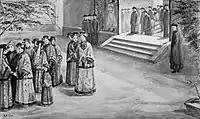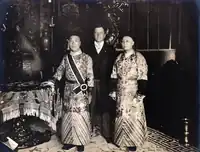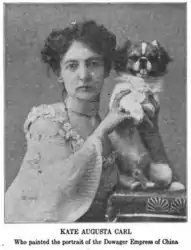Katharine Carl
Katharine Augusta Carl (February 12, 1865 – December 7, 1938) (sometimes spelled Katherine Carl) was an American portrait painter and author. She made paintings of notable and royal people in the United States, Europe and Asia. She spent nine months in China in 1903 painting a portrait of the Empress Dowager Cixi for the St. Louis Exposition. On her return to America, she published a book about her experience, titled With the Empress Dowager of China.
Katharine Carl | |
|---|---|
 | |
| Born | February 12, 1865 |
| Died | December 7, 1938 (aged 73) |
| Education | Gustave-Claude-Etienne Courtois and William-Adolphe Bouguereau |
| Alma mater | Tennessee State Female College (Master of Arts) |
| Occupation(s) | Painter and author |
| Known for | Portraits of Empress Cixi |
Early life
Katharine Augusta Carl was born in New Orleans, Louisiana on February 12, 1865,[1] the daughter of Francis Augustus Carl, Ph.D., LL.D. and Mary Breadon Carl.[2] She had a brother named Francis A. Carl.[3]
Education
Carl graduated with a Master of Arts from the Tennessee State Female College in 1882. She studied art under Gustave-Claude-Etienne Courtois and William-Adolphe Bouguereau in Paris, and then exhibited her works in the Paris salons.[2][4]
Career
Overview
Carl painted portraits, including those made in 1892 of Mahomet Ali and Prince El Hadj in Algiers.[2] She made portraits of Paul S. Reinsch and Sir Richard Dame.[5]
Throughout her career, she traveled and painted in Europe and China many times.[4][5] Carl exhibited her work at the Palace of Fine Arts and The Woman's Building at the 1893 World's Columbian Exposition in Chicago, Illinois.[6] In London, she was a member of the Lyceum Club and the International Society of Women Painters. She was a member of the Société des Artistes Français of Paris, the International Jury of Fine Arts, and the International Jury of Applied Arts of the St. Louis Exposition.[4]
China and Empress Dowager Cixi
Katharine Carl was contacted by Sarah Pike Conger, the wife of American Ambassador Edwin H. Conger with an offer to come to China in the summer of 1903 to paint a portrait of the Empress Dowager Cixi for the Chinese exhibit at the 1904 Louisiana Purchase Exposition.[7] She spent a total of nine months in China and painted four portraits of the Empress Dowager, later recording her memories as the only western foreigner to live within the precincts of the Chinese imperial court in its last days in a book that was published in 1906.[5]
I was obliged to follow, in every detail, centuries-old conventions. There could be no shadows and very little perspective, and everything must be painted in such full light as to lose all relief and picturesque effect. When I saw I must represent Her Majesty in such a conventional way as to make her unusually attractive personality banal, I was no longer filled with the ardent enthusiasm for my work with which I had begun it, and I had many a heartache and much inward rebellion before I settled on the inevitable.
— Katharine Carl, With the Empress Dowager of China[8]
She stayed there under the provision that she did not share information about Forbidden City.[7] The Empress Dowager honored Carl with the Order of the Double Dragon and the Flaming Pearl.[2][4]
Katharine Carl wrote of her time in China provide a unique and intimate assessment of the Empress Dowager Cixi, in the book With the Empress Dowager of China.[8][nb 1] To her dismay, the press incorrectly reported that she made unflattering remarks about the Empress.[7]
Carl's brother, Francis, worked for Sir Robert Hart at the Imperial Chinese Maritime Customs Service. She apparently stayed at Hart's house at some point and was described by him as "very breezy - quite a tornado".[3] While in China, she painted portraits of H.E. Tseng, former Lord Chamberlain to the Chinese Emperor, and former president of the Republic of China, Li Yuanhung.[4][5]
Personal life
She lived in New York City at 51 Washington Square[10] and had a studio in the city.[5]
In her later years she lived on East Seventy Eight Street in New York City. Carl died December 7, 1938 of burns at Lenox Hill Hospital she received when taking a bath at her apartment.[4][5]
In popular culture
Katharine Carl was portrayed by Sylvia in the 2006 Chinese television series Princess Der Ling.
Gallery
 Empress Dowager Cixi, 1904, was given to President Theodore Roosevelt, who had it added to the Smithsonian Institution collections[11]
Empress Dowager Cixi, 1904, was given to President Theodore Roosevelt, who had it added to the Smithsonian Institution collections[11] Court in the Winter Place, 1904
Court in the Winter Place, 1904 Prince Pu Lun, Francis A. Carl (Katharine Carl's brother), and Wong Kai Koh at the Chinese Reception at the 1904 World's Fair, where her painting was exhibited.[12]
Prince Pu Lun, Francis A. Carl (Katharine Carl's brother), and Wong Kai Koh at the Chinese Reception at the 1904 World's Fair, where her painting was exhibited.[12] Kate Augusta Carl and a small dog, from a 1905 publication.
Kate Augusta Carl and a small dog, from a 1905 publication. Katharine Carl, An Oriental Beauty, made in 19th century
Katharine Carl, An Oriental Beauty, made in 19th century
Notes
- Carl's experiences with the Dowager Empress are further detailed by Muriel Jernigan in Forbidden City. Jernigan lived in Peking until the 1912 revolution.[9]
References
- Passport Application for Katharine Carl, dated October 10, 1918. Passport Applications, January 2, 1906–March 31, 1925. NARA Microfilm Publication M1490, 2740 rolls. General Records of the Department of State, Record Group 59. National Archives, Washington, D.C.
- Who's who in New York City and State. L.R. Hamersly Company; 1911. p. 146.
- letter no. 1320, The I.G. in Peking, II, ed. by Fairbank et al., Cambridge, Mass., 1975
- Woman Painter Dies from Scalds. New York Times. December 9, 1938.
- David Shavit. The United States in Asia: A Historical Dictionary. Greenwood Publishing Group; 1 January 1990. ISBN 978-0-313-26788-8. p. 80–81.
- Nichols, K. L. "Women's Art at the World's Columbian Fair & Exposition, Chicago 1893". Retrieved 5 August 2018.
- The Century Illustrated Monthly Magazine. Century Company; 1905. p. 803.
- Katherine A. Carl. With The Empress Dowager Of China. Kessinger Publishing; 1 May 2004. ISBN 978-1-4179-1701-3. (Library of Congress pdf version)
- Muriel Molland Jernigan. Forbidden City. Crown Publishers; 1954.
- Thomas William Herringshaw. Herringshaw's American Blue-book of Biography: Prominent Americans.. American Publishers' Association; 1914. p. 180.
- Empress Dowager Cixi. Smithsonian American Art Museum. Retrieved March 18, 2014.
- China's Exhibit at St. Louis. New York Times. April 27, 1903. Retrieved March 18, 2014.
Further reading
- Muriel Molland Jernigan, Forbidden City, New York, Crown Publishers, 1954.
- Lolan Wang Grady, Book Review of With the Empress Dowager Of China by Katharine Augusta Carl, Association of Universities and Colleges of Canada, Ottawa.
External links
- Works by Katharine Carl at LibriVox (public domain audiobooks)
